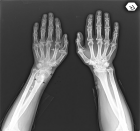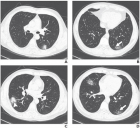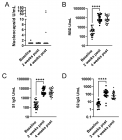Abstract
Research Article
Investigate the Effect of Coating Concentration and Coating Thickness on the Anti-microbial Properties of Polycarbonate Sheet
Saleh Alkarri
Published: 29 May, 2024 | Volume 8 - Issue 1 | Pages: 011-020
This paper investigates the effect of coating concentration (ppm), and coating thickness (µm) on the anti-microbial properties of polycarbonate sheets using a variety of anti-microbial agents
(Cu-infused Mg(OH)2, Mg(OH)2, Cu(OH)2, MgO, CuCl2.2H2O, and ZnO). In addition, a complete analysis was performed for all agents to rank the best agent in terms of the highest anti-microbial performance against E. coli K-12 MG1655 in two time intervals (4 and 24 hours). The coating concentration (ppm) was found to be a significant factor in the anti-microbial characteristics for Cu-infused Mg(OH)2, Mg(OH)2, Cu(OH)2, MgO, CuCl2.2H2O, and ZnO (p = 0.004, p < 0.0001, p < 0.0001, p = 0.0297,
p = 0.0011, and p = 0.0130 respectively). The coating thickness (µm), on the other hand, was found to be a major contributor to the anti-microbial properties of Cu-infused Mg(OH)2, Mg(OH)2, Cu(OH)2, MgO, and CuCl2.2H2O (p < 0.0001, p = 0.0004, p = 0.0011, p = 0.0310, and p < 0.0001 respectively). The analysis determined that the coating did not influence the anti-microbial properties of ZnO. The interaction between the coating concentration (ppm), and the coating thickness (µm) was found to be a significant factor for Cu-infused Mg(OH)2, Cu(OH)2, MgO, CuCl2.2H2O, and ZnO (p < 0.0001,
p = 0.0001, p = 0.0004, p < 0.0001, and p < 0.0001 respectively), however, this was not a significant factor for Mg(OH)2.
Highlights
• The anti-microbial activity of the inorganic material is dependent on the particle shape and size.
• Particles with sharp edges will provide additional physical injuries to the microorganisms.
• Smaller particle size will provide higher surface area therefore better interaction with microorganisms.
• The coating concentration and coating thickness will be crucial to the anti-microbial activity.
• The thermal embossing techniques demonstrate good adhesion to the surface.
Read Full Article HTML DOI: 10.29328/journal.abse.1001029 Cite this Article Read Full Article PDF
Keywords:
Anti-microbial activity; E. coli K-12 MG1655; Thermal embossing; Coating concentration; Coating thickness
References
- Tuson HH, Weibel DB. Bacteria-surface interactions. Soft Matter. 2013 Sep 28;9(18):4368-4380. DOI: 10.1039/c3sm27705d.
- Kimkes TEP, Heinemann M. How bacteria recognise and respond to surface contact. FEMS Microbiol Rev. 2020 Jan 1;44(1):106-122. doi: 10.1093/femsre/fuz029. PMID: 31769807; PMCID: PMC7053574.
- Sacher E. Comment on “High-Resolution Microscopical Studies of Contact Killing Mechanisms on Copper-Based Surfaces”. ACS Appl Mater Interfaces. 2022 Apr 20; 14(15):16959-16960.
- Stephens B, Azimi P, Thoemmes MS, Heidarinejad M, Allen JG, Gilbert JA. Microbial Exchange via Fomites and Implications for Human Health. Curr Pollut Rep. 2019;5(4):198-213. doi: 10.1007/s40726-019-00123-6. Epub 2019 Aug 31. PMID: 34171005; PMCID: PMC7149182.
- Jose A, Gizdavic-Nikolaidis M, Swift S. Antimicrobial Coatings: Reviewing Options for Healthcare Applications. 2023 Jan; 3(1):145-174.
- Lakshmipriya T. Introduction to nanoparticles and analytical devices. 2021; 1-29.
- Mahanta U, Khandelwal M, Deshpande AS. Antimicrobial surfaces: a review of synthetic approaches, applicability and outlook. J Mater Sci. 2021;56(32):17915-17941. doi: 10.1007/s10853-021-06404-0. Epub 2021 Aug 10. PMID: 34393268; PMCID: PMC8354584.
- Pinho AC, Piedade AP. Polymeric Coatings with Antimicrobial Activity: A Short Review. Polymers (Basel). 2020 Oct 24;12(11):2469. doi: 10.3390/polym12112469. PMID: 33114426; PMCID: PMC7692441.
- Qiu H, Si Z, Luo Y, Feng P, Wu X, Hou W, Zhu Y, Chan-Park MB, Xu L, Huang D. The Mechanisms and the Applications of Antibacterial Polymers in Surface Modification on Medical Devices. Front Bioeng Biotechnol. 2020 Nov 11;8:910. doi: 10.3389/fbioe.2020.00910. PMID: 33262975; PMCID: PMC7686044.
- Alves MM, Batista C, Mil-Homens D, Grenho L, Fernandes MH, Santos CF. Enhanced antibacterial activity of Rosehip extract-functionalized Mg(OH)2nanoparticles: An in vitro and in vivo study. Colloids Surf B Biointerfaces. 2022 Sep;217:112643. doi: 10.1016/j.colsurfb.2022.112643. Epub 2022 Jun 15. PMID: 35759895.
- Mieszkowska M, Grden M. Electrochemical deposition of nickel targets from aqueous electrolytes for medical radioisotope production in accelerators: a review. J Solid State Electrochem. 2021; 25. DOI: 10.1007/s10008-021-04950-w.
- Auclair J, Turcotte P, Gagnon C, Peyrot C, Wilkinson KJ, Gagné F. The Influence of Surface Coatings of Silver Nanoparticles on the Bioavailability and Toxicity to Elliptio complanata Mussels. J Nanomater. 2019; 2019:7843025. doi: 10.1155/2019/7843025.
- Birkett M, Dover L, Cherian Lukose C, Wasy Zia A, Tambuwala MM, Serrano-Aroca Á. Recent Advances in Metal-Based Antimicrobial Coatings for High-Touch Surfaces. Int J Mol Sci. 2022 Jan 21;23(3):1162. doi: 10.3390/ijms23031162. PMID: 35163084; PMCID: PMC8835042.
- Zhou Q, Li G, Zhou Z, Qu Y, Chen R, Gao X, Xu W, Nie S, Tian C, Li R. Effect of Ni2+ concentration on microstructure and bonding capacity of electroless copper plating on carbon fibers. J Alloys Compd. 2021;863:158467.
- Bruenke J, Roschke I, Agarwal S, Riemann T, Greiner A. Quantitative Comparison of the Antimicrobial Efficiency of Leaching versus Nonleaching Polymer Materials. Macromol Biosci. 2016 May;16(5):647-54. doi: 10.1002/mabi.201500266. Epub 2016 Jan 25. PMID: 26806336.
- Alkarri S, Bin Saad H, Soliman M. On Antimicrobial Polymers: Development, Mechanism of Action, International Testing Procedures, and Applications. Polymers (Basel). 2024 Mar 11;16(6):771. doi: 10.3390/polym16060771. PMID: 38543377; PMCID: PMC10975620.
- Cyphert EL, von Recum HA. Emerging technologies for long-term antimicrobial device coatings: advantages and limitations. Exp Biol Med (Maywood). 2017 Apr;242(8):788-798. doi: 10.1177/1535370216688572. Epub 2017 Jan 1. PMID: 28110543; PMCID: PMC5407537.
- Mullen DC, Wan X, Takala TM, Saris PE, Moreira VM. Precision Design of Antimicrobial Surfaces. Front Med Technol. 2021 Feb 16;3:640929. doi: 10.3389/fmedt.2021.640929. PMID: 35047910; PMCID: PMC8757849.
- Cuadros-Rodríguez L, Lazúen-Muros M, Ruiz-Samblás C, Navas-Iglesias N. Leachables from plastic materials in contact with drugs. State of the art and review of current analytical approaches. Int J Pharm. 2020 Jun 15;583:119332. doi: 10.1016/j.ijpharm.2020.119332. Epub 2020 Apr 28. PMID: 32360549.
- Gonzalez-Martin C. Airborne Infectious Microorganisms. In: Encyclopedia of Microbiology. 2019:52-60.
- Goodoory VC, Black CJ, Ford AC. Efficacy of Senna and Magnesium Oxide for the Treatment of Chronic Idiopathic Constipation. Am J Gastroenterol. 2021 Jun 1;116(6):1352-1353. doi: 10.14309/ajg.0000000000001041. PMID: 33136565.
- Mokabber T, Cao HT, Norouzi N, van Rijn P, Pei YT. Antimicrobial Electrodeposited Silver-Containing Calcium Phosphate Coatings. ACS Appl Mater Interfaces. 2020 Feb 5;12(5):5531-5541. doi: 10.1021/acsami.9b20158. Epub 2020 Jan 14. PMID: 31894959; PMCID: PMC7252902.
- Darvish M, Ajji A. Effect of Polyethylene Film Thickness on the Antimicrobial Activity of Embedded Zinc Oxide Nanoparticles. ACS Omega. 2021 Sep 29;6(40):26201-26209. doi: 10.1021/acsomega.1c03223. PMID: 34660979; PMCID: PMC8515594.
- Kania H, Sipa J. Microstructure Characterization and Corrosion Resistance of Zinc Coating Obtained on High-Strength Grade 10.9 Bolts Using a New Thermal Diffusion Process. Materials (Basel). 2019 Apr 29;12(9):1400. doi: 10.3390/ma12091400. PMID: 31032815; PMCID: PMC6539789.
- Lin J, Nguyen NT, Zhang C, Ha A, Liu HH. Antimicrobial Properties of MgO Nanostructures on Magnesium Substrates. ACS Omega. 2020 Sep 18;5(38):24613-24627. doi: 10.1021/acsomega.0c03151. PMID: 33015479; PMCID: PMC7528336.
- Alkarri S. Developing Methods for Incorporating Antimicrobial Biocidal Nanoparticles in Thermoplastics. Michigan State University, 2023.
- Nakamura Y, Okita K, Kudo D, Phuong DND, Iwamoto Y, Yoshioka Y, Ariyoshi W, Yamasaki R. Magnesium Hydroxide Nanoparticles Kill Exponentially Growing and Persister Escherichia coliCells by Causing Physical Damage. Nanomaterials (Basel). 2021 Jun 16;11(6):1584. doi: 10.3390/nano11061584. PMID: 34208716; PMCID: PMC8234494.
- Okamoto K, Kudo D, Phuong DND, Iwamoto Y, Watanabe K, Yoshioka Y, Ariyoshi W, Yamasaki R. Magnesium Hydroxide Nanoparticles Inhibit the Biofilm Formation of Cariogenic Microorganisms. Nanomaterials (Basel). 2023 Feb 25;13(5):864. doi: 10.3390/nano13050864. PMID: 36903742; PMCID: PMC10005196.
- Vandebriel RJ, De Jong WH. A review of mammalian toxicity of ZnO nanoparticles. Nanotechnol Sci Appl. 2012 Aug 15;5:61-71. doi: 10.2147/NSA.S23932. PMID: 24198497; PMCID: PMC3781722.
- Halbus AF, Horozov TS, Paunov VN. Controlling the Antimicrobial Action of Surface Modified Magnesium Hydroxide Nanoparticles. Biomimetics (Basel). 2019 Jun 25;4(2):41. doi: 10.3390/biomimetics4020041. PMID: 31242662; PMCID: PMC6631741.
- Nguyen NT, Grelling N, Wetteland CL, Rosario R, Liu H. Antimicrobial Activities and Mechanisms of Magnesium Oxide Nanoparticles (nMgO) against Pathogenic Bacteria, Yeasts, and Biofilms. Sci Rep. 2018 Nov 2;8(1):16260. doi: 10.1038/s41598-018-34567-5. PMID: 30389984; PMCID: PMC6214931.
- Alkarri S, Sharma D, Bergholz TM, Rabnawaz M. Fabrication methodologies for antimicrobial polypropylene surfaces with leachable and nonleachable antimicrobial agents. J Appl Polym Sci. 2023; e54757.
- Maddan OL. Hydroxides monolayer nanoplatelet and methods of preparing same. Google Patents: 2022.
- Maddan OL. Nanoplatelet copper hydroxides and methods of preparing same. Google Patents: 2008.
Figures:
Similar Articles
-
Investigate the Effect of Coating Concentration and Coating Thickness on the Anti-microbial Properties of Polycarbonate SheetSaleh Alkarri. Investigate the Effect of Coating Concentration and Coating Thickness on the Anti-microbial Properties of Polycarbonate Sheet. . 2024 doi: 10.29328/journal.abse.1001029; 8: 011-020
-
Relationship between Particle Size, Anti-Microbial Activity and Leachability of Copper Particles in Liquid Suspension and Compounded in PolypropyleneSaleh Alkarri*, Jérôme Vachon. Relationship between Particle Size, Anti-Microbial Activity and Leachability of Copper Particles in Liquid Suspension and Compounded in Polypropylene. . 2024 doi: 10.29328/journal.abse.1001030; 8: 021-031
Recently Viewed
-
Artificial Intelligence in the Pharmaceutical Galenic Field: A Useful Tool with Associated RisksLuisetto M*,Ferraiuolo A,Fiazza C,Cabianca L,Edbey K,Mashori GR,Abdul Hamid G,Latyshev Oleg Yurevich. Artificial Intelligence in the Pharmaceutical Galenic Field: A Useful Tool with Associated Risks. Arch Pharm Pharma Sci. 2025: doi: 10.29328/journal.apps.1001066; 9: 014-020
-
Drinking-water Quality Assessment in Selective Schools from the Mount LebanonWalaa Diab, Mona Farhat, Marwa Rammal, Chaden Moussa Haidar*, Ali Yaacoub, Alaa Hamzeh. Drinking-water Quality Assessment in Selective Schools from the Mount Lebanon. Ann Civil Environ Eng. 2024: doi: 10.29328/journal.acee.1001061; 8: 018-024
-
Biomarkers in Enteropathic ArthritisLuis Arturo Gutiérrez-Gonzalez*,Eillen Macias,Freddy Herrera-Vivas,Franz Otaiza,Juan Carlos Gonzalez Duran,Guillermo Veitia. Biomarkers in Enteropathic Arthritis. Ann Clin Gastroenterol Hepatol. 2020: doi: 10.29328/journal.acgh.1001021; 4: 039-044
-
Isolation and Influence of Carbon Source on the Production of Extracellular Polymeric Substance by Bacteria for the Bioremediation of Heavy Metals in Santo Amaro CityLeila Thaise Santana de Oliveira Santos*, Kayque Frota Sampaio, Elisa Esposito, Elinalva Maciel Paulo, Aristóteles Góes-Neto, Amanda da Silva Souza, Taise Bomfim de Jesus. Isolation and Influence of Carbon Source on the Production of Extracellular Polymeric Substance by Bacteria for the Bioremediation of Heavy Metals in Santo Amaro City. Ann Civil Environ Eng. 2024: doi: 10.29328/journal.acee.1001060; 8: 012-017
-
Management and use of Ash in Britain from the Prehistoric to the Present: Some implications for its PreservationJim Pratt*. Management and use of Ash in Britain from the Prehistoric to the Present: Some implications for its Preservation. Ann Civil Environ Eng. 2024: doi: 10.29328/journal.acee.1001059; 8: 001-011
Most Viewed
-
Feasibility study of magnetic sensing for detecting single-neuron action potentialsDenis Tonini,Kai Wu,Renata Saha,Jian-Ping Wang*. Feasibility study of magnetic sensing for detecting single-neuron action potentials. Ann Biomed Sci Eng. 2022 doi: 10.29328/journal.abse.1001018; 6: 019-029
-
Evaluation of In vitro and Ex vivo Models for Studying the Effectiveness of Vaginal Drug Systems in Controlling Microbe Infections: A Systematic ReviewMohammad Hossein Karami*, Majid Abdouss*, Mandana Karami. Evaluation of In vitro and Ex vivo Models for Studying the Effectiveness of Vaginal Drug Systems in Controlling Microbe Infections: A Systematic Review. Clin J Obstet Gynecol. 2023 doi: 10.29328/journal.cjog.1001151; 6: 201-215
-
Prospective Coronavirus Liver Effects: Available KnowledgeAvishek Mandal*. Prospective Coronavirus Liver Effects: Available Knowledge. Ann Clin Gastroenterol Hepatol. 2023 doi: 10.29328/journal.acgh.1001039; 7: 001-010
-
Causal Link between Human Blood Metabolites and Asthma: An Investigation Using Mendelian RandomizationYong-Qing Zhu, Xiao-Yan Meng, Jing-Hua Yang*. Causal Link between Human Blood Metabolites and Asthma: An Investigation Using Mendelian Randomization. Arch Asthma Allergy Immunol. 2023 doi: 10.29328/journal.aaai.1001032; 7: 012-022
-
An algorithm to safely manage oral food challenge in an office-based setting for children with multiple food allergiesNathalie Cottel,Aïcha Dieme,Véronique Orcel,Yannick Chantran,Mélisande Bourgoin-Heck,Jocelyne Just. An algorithm to safely manage oral food challenge in an office-based setting for children with multiple food allergies. Arch Asthma Allergy Immunol. 2021 doi: 10.29328/journal.aaai.1001027; 5: 030-037

HSPI: We're glad you're here. Please click "create a new Query" if you are a new visitor to our website and need further information from us.
If you are already a member of our network and need to keep track of any developments regarding a question you have already submitted, click "take me to my Query."

















































































































































